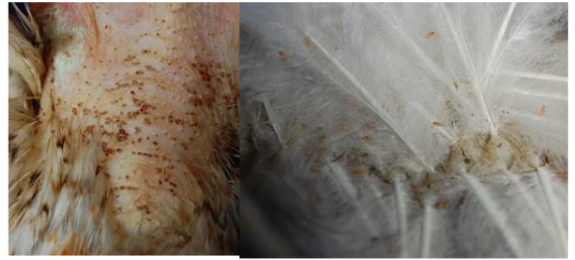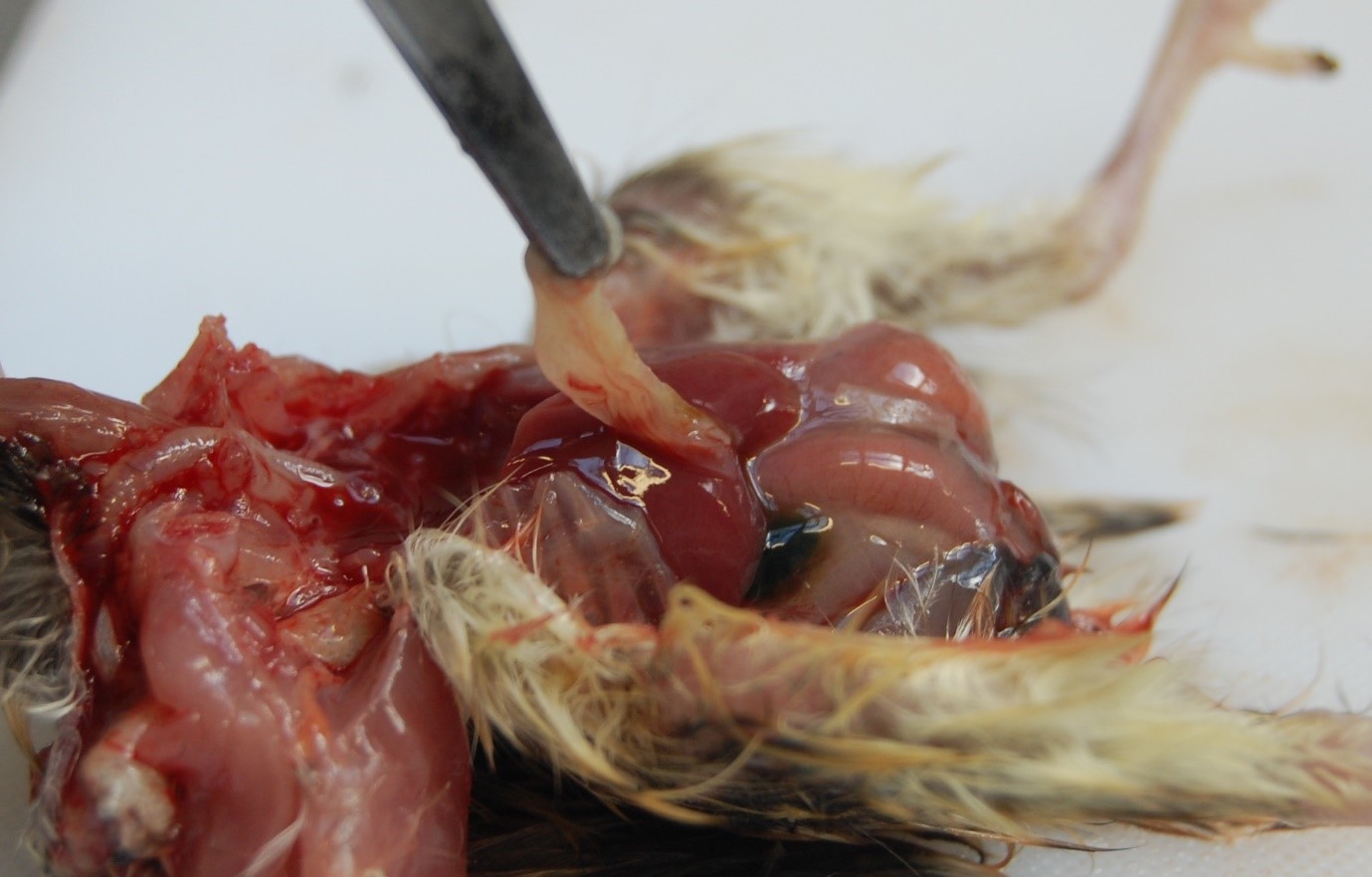June case highlights
The submissions through the Aberdeen PM room remained steady throught the month of June. In cattle, bacterial pneumonia caused by the Pasteurellaceae family featured strongly, alongside abomasal bloat/rupture in calves and parasitic disease including ostertagiasis and chronic fluke. In sheep we diagnosed Nematodirus in five submissions, as well as pasteurellosis and Mannheimiosis in lambs. Several bird cases of interest are also included in our case highlights.
- Broiler ascites/ pulmonary hypertension syndrome
- Cerebellar abiotrophy in an Aberdeen Angus calf
- Perinatal deaths due to Bacillus licheniformis
- Deaths in a smallholder flock due to Poultry red mite
- Mortality due to Salmonella Typhimurium in pheasant chicks
Broiler ascites/ pulmonary hypertension syndrome was diagnosed as a cause of death in six ten-week-old broilers submitted for postmortem examination. 500 were broilers present on the commercial unit, where 20 birds out of a group of around 160 had been found dead within a few days. The birds had been purchased as day-old chicks and were kept in outdoor moveable pens with a covered roof and mesh sides, measuring three by four metres, with 60 birds per pen. A gross diagnosis was made by post-mortem examination where characteristic findings of ascites with fibrin formation, hydropericardium, pulmonary congestion and oedema were detected in all birds. In some of the birds there was also evidence of enlarged, dilated hearts and liver enlargement. The physiopathogenesis is associated with an increased workload of the heart and oxygen demand coupled with an overall insufficient pulmonary capillary capacity and decreased respiratory efficiency in rapidly growing broiler birds. Poor ventilation is the main risk factor for development of disease and ensuring adequate ventilation in the outdoor pens was encouraged to lower the prevalence of disease in the flock. Additional methods include selecting stock which are bred for cardiovascular fitness, decreasing the growth rates, restricting food intake and modifying food type; the broilers were fed pellets, which seem to increase feed efficiency and thus metabolic demand.

Broiler ascites/pulmonary hypertension syndrome. Ascites, hydropericardium, and pulmonary congestion and oedema .
Cerebellar abiotrophy was diagnosed as a cause of hindlimb ataxia in a one-month-old female Aberdeen Angus calf. The suckler calf was born outside in a group of 30 cows and calves and the clinical signs did not present until it was two weeks old. The calf was noted to have hind limb ataxia. The calf's mentation and front limb coordination were unremarkable. The calf was euthanised for further investigation and no gross abnormalities were detected on post-mortem examination; however histopathological examination of the CNS made the diagnosis. Cerebellar abiotrophy is characterised by a normal development of the cerebellum in utero, and the animal remains unaffected for a period of months or even years before cerebellar neurons begin to die off prematurely. The condition has previously been reported in a number of cattle breeds including Aberdeen Angus. In some cases, a familial component has been identified but in others the cause remains unknown. No other calves or adult cattle from the farm have been affected to date, however due to the potentially very long incubation period of the condition and monitoring for further cases on farm may help identify the aetiology.
Perinatal deaths due to Bacillus licheniformis was diagnosed in a group of 23 late pregnant suckler cows where five had either an aborted foetus, stillbirth or non-viable full term calf within a two week period. The group had been on good quality pasture since mid-May with no other feed provided. Two calves were submitted (both had died in the immediate perinatal period) and in both cases marked placentits was present. Bacillus licheniformis was isolated from one of the two submissions (pure growth from FSC). B. licheniformis is the most commonly diagnosed cause of abortion in cattle in Scotland, with abortions most common in housed, pit silage fed, spring calving beef cows in the last two months of gestation. While abortions are usually associated with feeding poorly conserved silage, which often has a mouldy or ‘slimy’ appearance, B. licheniformis can also be found in slurry and water troughs. Since no forage had been fed since May, potential sources of infection were discussed with the practice, and the field water trough was thought to be the most likely source.

Placentitis due to Bacillus licheniformis causing a high incidence of peri-natal losses in a group of late pregnant suckler cows.
Ectoparasitic burden including Dermanyssus gallinae (poultry red mite). A hen and cockerel from an established hobby flock of 5 adult birds died within a week, with no prior clinical signs having been noted. The cockerel was submitted for examination and D. gallinae mites were noted in the box in which the carcase was delivered. Generalised carcase pallor and a watery appearance of the blood were observed on gross examination, and D. gallinae (poultry red mite), Ornythonyssus sylviarum (Northern fowl mite) and Menopon sp. (chicken body louse) were noted on the carcase. D. gallinae was considered the most significant with respect to the death of the animal, and the large numbers of the other ectoparasites likely to have both been a result of the birds debilitated state. The keel bone had an ‘S’ shaped deformity and the right kidney was aplastic, both were considered incidental findings in a three year old bird. Red mite can be challenging to manage, as the nocturnal mites retreat into crevices in the coop after feeding. Management with diatomaceous earth combined with cleaning and disinfection can be considered, as treatment with fluralaner (Exzolt) can be cost prohibitive in small flocks (although some specialist poultry practices may dispense smaller quantities under veterinary prescription).
Further information: Kenyon, J., 2017. Red mites in backyard chickens. In Practice, 39(7), pp.334-338.

Dermanyssus gallinae (poultry red mite) and Ornythonyssus sylviarum (Northern fowl mite) on the ventral neck of the bird. Menopon sp. (chicken body louse) were numerously present when the body feathers were parted.
Salmonellosis in pheasants due to Salmonella Typhimurium. Six live 13-day-old pheasant chicks were submitted from an estate with 20,000 stock. There were 12,000 birds in the affected age-group, housed in groups of 1,000. Approximately 40% were showing non-specific clinical signs of malaise and just over 10% had died. Disease presented at four days old in a few birds and by day five numerous birds were affected and antibiotic treatment commenced. Mortalities reduced within 24 hours, however a low rate of clinical signs and mortalities continued, and the cause was therefore investigated. The live submitted chicks were listless, weak and some unable to rise. At post-mortem examination it was apparent that chicks had failed to thrive, weights ranged from 24 to 60 grams. There were signs of systemic septicaemia with pericarditis and peritonitis variably present. All presented chicks were small in size and had a persistent yolk sac filled with dry, firm yellow material. Bacteriology revealed a suspect Salmonella organism from systemic sites including lung, liver, heart blood, pericardial fluid, caecal content and yolk sac. The isolate was identified as Salmonella Typhimurium serotype 19 (10,7,12,9,5,9,2). Salmonella infections in gamebirds, particularly with S. Typhimurium, typically cause high mortality, especially in the first two to three weeks of life. Post-mortem lesions include pericarditis, perihepatitis and caseous caecal cores. Advice was given regarding the zoonotic potential of Salmonella organisms and that personal hygiene precautions should be taken accordingly.

Fibrinous clot in peritoneal cavity of 13 day-old pheasant chick
We hope you have enjoyed our summary of interesting cases. If we can be of any help with your own on farm post mortem examinations, please don’t hesitate to get in touch.
Posted by SRUC Veterinary Services on 04/08/2023
